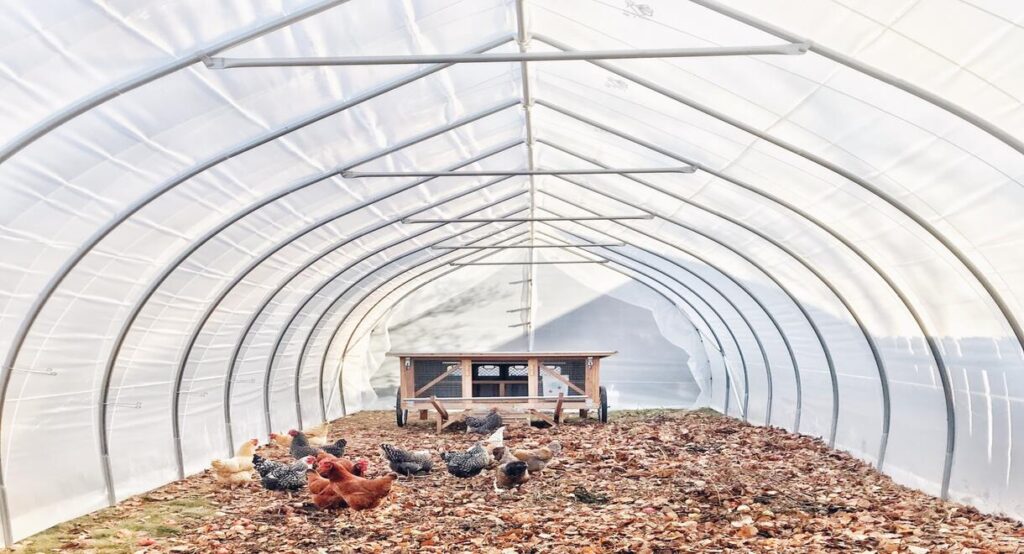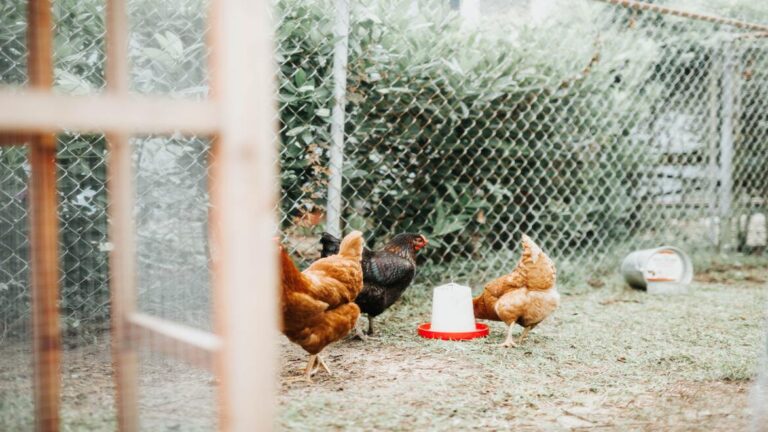The coop is a necessity if you’re raising a flock of chickens. Chickens require a secure location to spend the night. You’ll also need a safe chicken coop door in case a predator comes calling. With basic supplies and tools, it is simple to construct a DIY coop door.
Why Can’t Chickens Use The People-Sized Door
Some newcomers enquire as to why they can’t simply leave the big coop door open during the day. Why aren’t the chickens just able to walk out this door and into the coop?
There are 3 main reasons why:
- The chicken coop needs to be protected from the elements
- The chicken coop needs to be protected from predators
- Chickens want privacy in the coop, particularly if they are laying eggs
In cold or bad weather, it is never a good idea to leave a large door open during the day. Widely open doors allow wind, rain, and snow to enter as well as cold air.
Your chickens must have a dry, draft-free coop in order for them to be healthy. Pathogens thrive in moist organic bedding (like straw or pine shavings). Additionally, cold chickens and frostbite are risks associated with wet coops.
I should mention that the doors to my chicken coop, which are people-sized, frequently catch the wind and slam shut. She would undoubtedly be hurt, if not killed if a chicken were to be in the doorway. Make sure your people-sized door is firmly held if you do decide to leave it open occasionally.
How To Build A Sliding Door For Your Chickens
The Size Of A Chicken Door
Since bantam chickens are obviously much smaller than large breeds, their doors may also be smaller.
Large breeds include Orpingtons, Brahmas, Cochins, Jersey Giants, and Langshans.
However, larger breeds can still fit through smaller doors. To prevent them from falling to the ground, you must make sure the pop door ramp is very shallow. Here is a cute video of a giant Brahma emerging from a tiny pop-hole door.
Typically, roosters are significantly bigger than hens. When selecting the height of your chicken door, you might want to keep this in mind.

The Threat Of Aerial Predators
This idea is taken from one of my favorite books by Gail Damerow, Storey’s Guide to Raising Chickens. Chickens enjoy perching on the pop-hole ledge and watching the world go by, the author observes. None of the other chickens can enter or exit that perch when a chicken is inside.”
The majority of the time, this is not a big issue. The chickens will either push their way past the bird while she is still perched or they will wait for her to move.
However, if your chicken coop is elevated off the ground, your chickens will probably seek refuge underneath the coop rather than attempting to enter the chicken door all at once.
Height Off The Ground
A chicken pop hole door should be how high? So that bedding doesn’t obstruct the doorway or spill outside, a chicken pop hole door should be placed 6–12 inches above the level of the chicken coop floor.
It doesn’t matter how high the door is from the ground outside the chicken coop as long as there is a ramp for the chickens to use to access doors that are 18 to 24 inches or higher.
Because most chicken coops require bedding, the chicken pop hole door isn’t at floor level. Check out my article What is chicken coop bedding and do you need it to learn if your coop requires it.
Chicken coop bedding doubles as a cushion and litter at the same time because chickens that jump from roosting bars or nesting boxes need a soft place to land so they don’t hurt themselves.
A piece of bedding can be three to eighteen inches thick. If you frequently switch out your bedding (e.g., once a week) and your roosting bars are low, you can get away with only 3 inches of bedding. Your bedding will eventually reach a thickness of 12 to 18 inches if you use the deep litter method.
When Should You Open And Close The Chicken Coop Door
Should you shut the door to a chicken coop at night? In order to keep predators like raccoons, skunks, dogs, weasels, foxes, and snakes out of the chicken coop, the door should be shut at night. Additionally shielding chickens from cold, drafts, and bad weather are closed chicken coop doors.
The only circumstances in which you should ever even think about leaving a chicken coop door open are when it is extremely hot outside (drafts are good), and you are certain that your run is completely predator-proof. Unfortunately, there are a lot of animals that enjoy eating chicken.
Automatic VS. Manual Chicken Coop Doors
- Pros Of Automatic Chicken Coop Doors
- You don’t have to get up early to let your chickens out
- You don’t have to remember to close the door at night
- If you aren’t home when it gets dark, you don’t have to worry about your chickens
- You can more easily leave your chickens to go on vacation
- Cons Of Automatic Chicken Coop Doors
- If the power supply fails, the door may be open at night, leaving your chickens unprotected and exposed to drafts
- Some automatic doors stop working if the temperature gets below freezing
- If the door closes before all your chickens are in the coop, they will be stuck in the run all night
Chicken Coop Door Latches
Additionally, you must ensure that the chicken door latches tightly to prevent predators from entering the coop at night.
There are several different types of latches you can use, including:
- Padlock-style with carabiner
- Bolt
- Self-Locking/Gravity Latch
- Snap hook and chain





